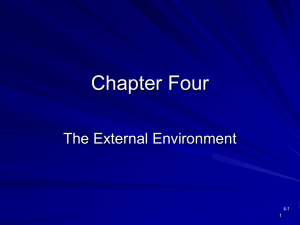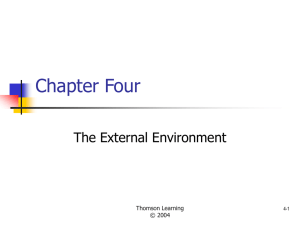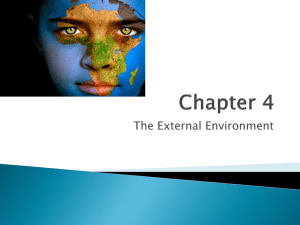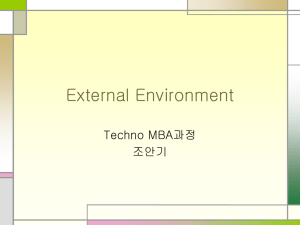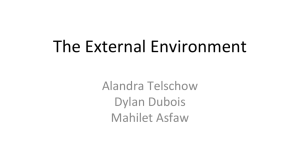Organizational Environments
advertisement
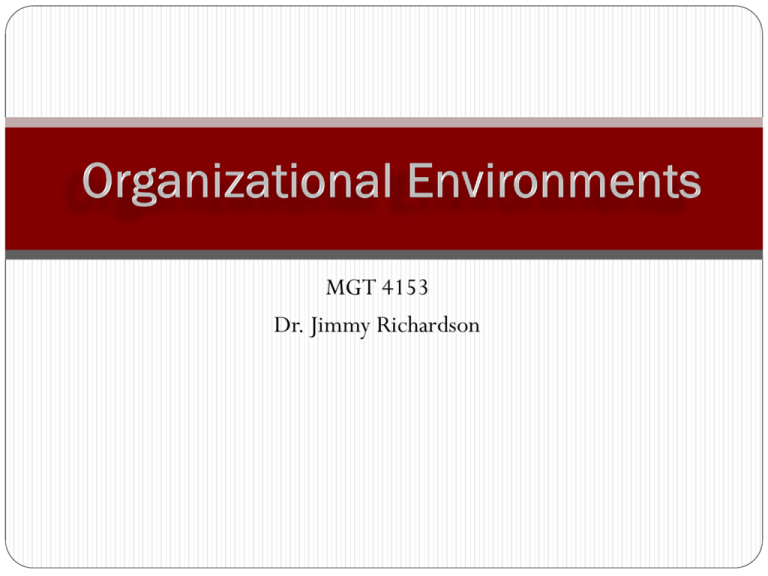
MGT 4153 Dr. Jimmy Richardson Tid-bits from Chapter 2 What do you wish to do? Why? Write a “future” mission statement. Write a vision. Develop a strategy. Develop goals to actionize strategy. (strategic direction) Strategic direction: (opportunities, threats, uncertainty, resource availability, strengths, distinctive competence, leader style, past performance) 2 Long Do you have a competitive advantage? Core competencies? Formulating strategies: Porter model and Miles and Snow strategy typology Porter: Differentiation vs low-cost leadership Miles and Snow: Prospector, Defender, Analyzer, Reactor Four Effectiveness Approaches: Goal approach, Resourcebased approach, Internal process approach, Strategic constituents approach 3 Long MGT 4153 Dr. Jimmy Richardson What is Structure? Designates formal reporting relationships Identifies grouping of individuals into units and units into the organization Includes design of systems to ensure communication, coordination and integration of effort 5 Long Designed for efficiency: Centralized Designed for learning: Decentralized 6 Long Information-sharing Perspective on Structure Design: Provide both vertical and horizontal information flow to accomplish organizational goals. If structure doesn’t fit, people will have either too little information or spend time processing information not vital to their tasks. Vertical linkages are designed primarily for control. Horizontal linkages are designed for coordination and collaboration, which usually means reducing control. 7 Long Design Options for Grouping Employees into Departments Functional Grouping CEO Engineering Marketing Divisional Grouping CEO Division A 8 Manufacturing Division B Long Division C Defined as all elements that exist outside the boundary of the organization and have the potential to affect all or part of the organization. Domain – Chosen environmental field of action. Eleven Sectors can be identified for most organizations. Sectors are usually divided into two subdivisions: Task and General Task – the industry, raw materials, market sectors, and perhaps HR and international sectors. General – Financial, Technology, Economic conditions, Government, Sociocultural An Organization’s Environment (Task & General) (a) Competitors, industry size and competitiveness, related issues (b) Suppliers, manufacturers, real estate, services (i) (c) Labor market, Sociocultural Sector employment agencies, universities, training schools, employees (h) in other companies, Government unionization Sector (d) Customers, clients, potential users of products (g) and services Economic Conditions (e) Stock markets, banks, Sector S&L, private investors (f) Techniques of production, science, computers, information technology 2 Long (g) Recession, unemployment rate, inflation rate, rate of investment, (j) (a) economics, growth International Industry (h) City, state, federal laws Sector Sector and regulations, taxes, (b) services, court system, DOMAIN Raw Materials political processes Sector (i) Age, values, beliefs, education, religion, (c) work ethic, consumer Human Resources and green ORGANIZATION Sector movements (j) Competition from (d) and acquisition by Market foreign firms, Sector entry into overseas (e) (f) Financial markets, foreign Technology Sector Sector customs, regulations, exchange rates The Changing Environment (pg 147) Complexity: heterogeneity (# and dissimilarity of external elements.) Dynamism: Is the environment in which the organization operates stable or unstable? Financial Resources (Abundance to Scarcity) 11 Long Simple-complex and stable-unstable dimensions, pg. 151 Low Uncertainty STABLE ENVIRONMENTAL CHANGE 1. Small number of elements, and elements are similar 2. Elements remain the same or change slowly 1. Large number of elements, and elements are dissimilar 2. Elements remain the same or change slowly Examples: Bottlers, distributors, container mfrs, food processors Examples: Universities, appliance mfrs, chemicals, insurance High-Moderate Uncertainty UNSTABLE Low-Moderate Uncertainty 1. Small number of elements, and elements are similar 2. Elements change frequently and unpredictably Examples: E-commerce, fashion, music, toys High Uncertainty 1. Large number of elements, and elements are dissimilar 2. Elements change frequently and unpredictably Examples: Computer firms, aerospace, telecomms, airlines COMPLEX SIMPLE ENVIRONMENTAL COMPLEXITY 12 Long Adapting to Uncertainty Positions and Departments Buffering and Boundary Spanning Differentiation and Integration Organic versus Mechanistic Planning and Forecasting 13 Long Adding to Complexity and Dynamism Adding positions and departments Building relationships Buffering roles – Purpose is to absorb uncertainty from the environment. Boundary spanning roles – Link and coordinate an organization with key elements in the external environment. (Computer chip mfg. must know the newest technology ) Differentiation and integration (quality of collaboration among departments) Organic vs mechanistic management processes Planning, forecasting and responsiveness 14 Long Organic vs mechanistic management processes. (p 159) Low Uncertainty 1. Mechanistic structure; formal, centralized 2. Few departments 1. Mechanistic structure; formal, centralized 2. Many departments, some boundary spanning 3. Few integrating roles 4. Some planning; moderate speed response STABLE 3. No integrating roles ENVIRONMENTAL CHANGE UNSTABLE Low-Moderate Uncertainty 4. Current operations orientation; low speed response High-Moderate Uncertainty 1. Organic structure, teamwork; participative, decentralized 2. Few departments, much boundary spanning 3. Few integrating roles 4. Planning orientation; fast response High Uncertainty 1. Organic structure, teamwork; participative, decentralized 2. Many departments differentiated, extensive boundary spanning 3. Many integrating roles 4. Extensive planning, forecasting; high speed response COMPLEX SIMPLE ENVIRONMENTAL COMPLEXITY 15 Long Controlling Environmental Resources (financial) Establishing Inter- organizational Linkages: Environmental Domain: Ownership Political activity, regulation Contracts, joint ventures Trade associations Cooptation, interlocking Illegitimate activities directorates Executive recruitment Advertising, public relations 16 Controlling the Long Change of domain Cooptation (p 162) Interlocking directorate (p 163) See Exhibit 4.9, p 167) 17 Long
